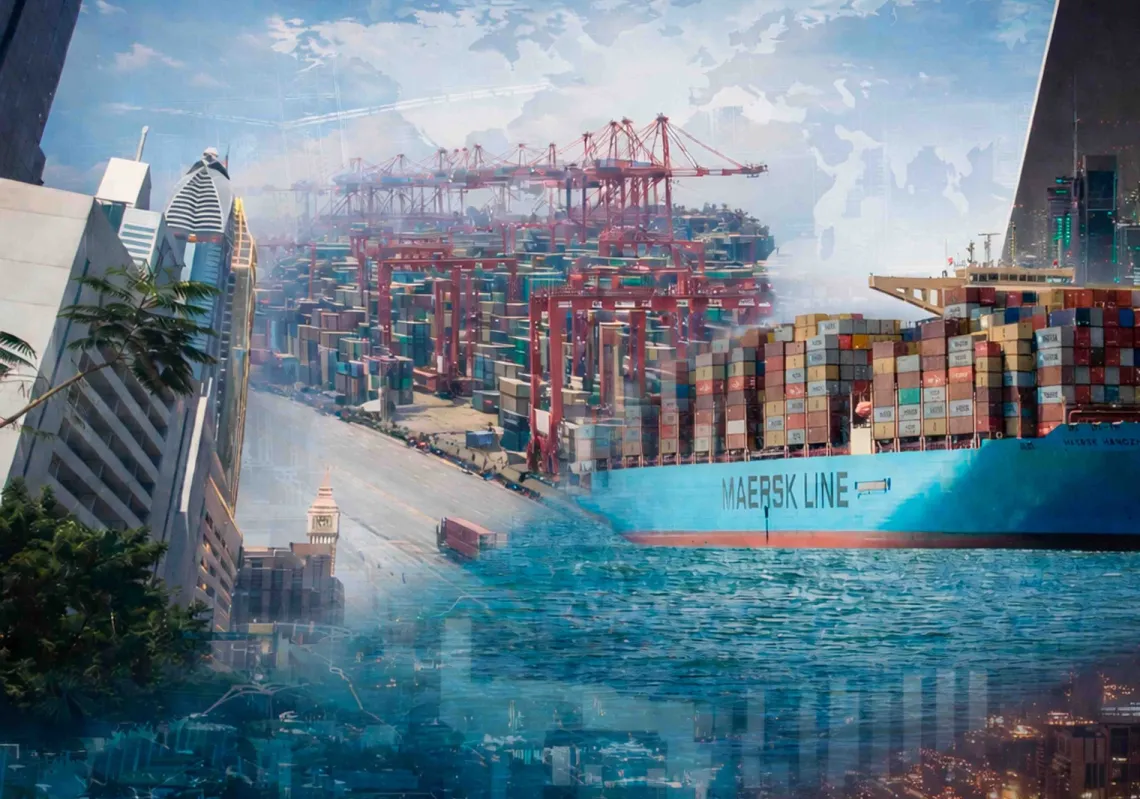In mid-November 2021, around the time the Omicron variant was first discovered in South Africa, the Chinese government all but declared victory over COVID-19. For more than 20 months, the country’s zero-COVID policy had come at a steep cost, with stringent controls and draconian lockdowns at the slightest sign of a local outbreak. But as Wu Zunyou, the chief epidemiologist of the Chinese Center for Disease Control and Prevention, said at the time, the strategy had prevented up to 200 million infections and three million deaths. It was an impressive record that seemed to set the stage for the Beijing Winter Olympics, which China has been determined to hold on schedule, in what would be a powerful demonstration of its success at pandemic control.
Two months later, the situation looks dramatically different. With the games now just days away, China has never seemed closer to an explosive COVID-19 surge. Since December 9, more than 3,000 locally transmitted cases have been reported in about 20 provinces. An outbreak in the northwestern city of Xi’an, with more than 2,000 domestic cases, was the country’s single worst since the Wuhan outbreak that began the global pandemic. And although Omicron is not yet dominant in China, cases caused by the highly transmissible variant have now been detected in at least 14 Chinese provinces.And these cases are despite lockdowns that have recently affected as many as 20 million people.
Notably, the city of Tianjin has reported more than 300 Omicron cases, raising concerns about a hidden Omicron outbreak in Beijing, which is just 30 minutes away via high-speed train; by January 15, an Omicron case had been detected in Beijing, one of some dozens of locally transmitted cases. Meanwhile, yet another Omicron outbreak has emerged in Hong Kong, with more than 100 cases detected in a single day this week. Although officials of the Olympics organizing committee insist that Beijing is under control and a full-scale lockdown is unnecessary, the community transmission of Omicron in Tianjin—even before the arrival of thousands of foreign athletes and their support staffs—has clearly rattled them. After the detection of Omicron in Beijing, the government stopped selling Olympics tickets to the general public, creating new uncertainty about the games and raising far-reaching questions about the continued viability of its zero-COVID strategy.
Now the Chinese government faces a growing dilemma. Other countries, including Australia, New Zealand, and Singapore, have long since moved away from a zero-COVID strategy; China remains the lone holdout. Even though the rapid spread of Omicron could quickly render zero-COVID unsustainable, China has stubbornly clung to the strategy—largely, it seems, out of fear of the perceived consequences of abandoning it. For one thing, the government has instilled deep fear about COVID-19 in the Chinese population. Conditioned to expect a case rate at or near zero, many Chinese are convinced that even a small pullback in the policy would lead to the infection and hospitalization of hundreds of millions of people.
The stakes are even higher because China has linked its zero-COVID strategy to its ideological competition with the United States and the West. For Beijing to give up on zero-COVID and allow the new variant to run its course would be tantamount to admitting that its political system is no better than Western liberal democracy in protecting people’s health. Yet to keep their zero-COVID strategy alive, central policymakers may find they have no choice but to impose an embarrassing lockdown in Beijing during the Olympics itself.
Zero Means Zero
From almost the beginning of the pandemic, China has staked its entire approach on a zero-COVID strategy. The strategy began in March 2020 when, as COVID-19 began to retreat in China while beginning its surge in other parts of the world, the Chinese government sought a way to sustain its “hard-won achievements.” During the early weeks of the pandemic, the prolonged Wuhan lockdown proved effective in containing the spread of the novel coronavirus. Meanwhile, the development of mass rapid-testing technologies enabled China to quickly ferret out new COVID-19 cases as they emerged, even in megacities. With these two tools—rapid testing and absolute lockdowns—the government set out to stamp out any sporadic local outbreaks, including when there is no evidence of community spread.
The resulting no-tolerance approach has been extraordinarily far-reaching. In June 2020, when a single new case was confirmed in Beijing, the local government quickly identified the origin point of the outbreak, sealed off high-risk neighborhoods, and launched mass testing of ten million people. Within a month, the daily new-case count returned to zero. What happened in Beijing soon became the standard playbook for COVID-19 control throughout the country. Over and over again, the detection of even a single case would trigger aggressive contact tracing and quarantine, mass nucleic acid testing, and severe lockdowns of neighborhoods or, if necessary, an entire city. It may sound quixotic, but the Chinese leadership has been determined to ensure that zero means zero.
For much of the pandemic, this strategy seemed to pay extraordinary dividends for the Chinese government. From April 2020 to December 2021, the case count for the entire country rarely exceeded 100 per day; even now, the official tally of total deaths related to COVID-19 in China is less than 5,000, whereas for much of the pandemic, the United States has surpassed that number every two or three days. Meanwhile, the extremely low level of infection allowed China to begin its economic recovery while the rest of the world remained mired in successive waves of contagion. Beijing’s export sector, for example, has remained resilient despite power cuts and shipping congestion. And as the world’s largest exporter of personal protective equipment and COVID-19 vaccines, China has also used its pandemic-fighting expertise to extend its global influence and reap commercial gains. Constantly talking about the failure of the United States and many other liberal democracies to bring the pandemic under control, Chinese officials touted their own success as a source of national pride, generating overwhelming public support for the government, at least in the realm of public health.
Far less noted, however, has been the colossal financial and social toll that the zero-COVID strategy has imposed on the country. The government has not made clear the economic costs of its policies, but local examples provide some indication of the staggering amounts in question: in order to stamp out a single outbreak of less than a few hundred cases in Guangzhou during May and June 2021, for example, the local government reportedly spent approximately $1 billion on testing for 32 million people. And because lockdowns have frequently involved entire municipalities, local businesses in disparate parts of the country have been forced to close abruptly for long stretches, keeping many people off-balance. In Zhengzhou, the capital of central Henan Province, more than 40 percent of local shops with street frontage closed down during a 26-day outbreak last August. According to Tianyancha, a business data and investigation platform, in the first 11 months of 2021, 4.37 million small businesses in China closed while only 1.32 million new ones registered, compared with 6.13 million new small businesses opening in 2020.
Arguably more significant to the regime, however, have been the accumulating social costs of zero-COVID: the continual inconvenience of invasive lockdowns, testing regimes, and limitations on movement; the separation of families due to stringent travel restrictions; the lack of access to run-of-the-mill health care; the disruption in local supply chains. In Ruili, a southwestern border city, repeated lockdowns have exacted so much disruption that the former deputy mayor described “serious emotional and material losses” and “piling-up resentment” among the local population. During one outbreak in that city in August 2021, when officials failed to lift a lockdown after two weeks as originally planned, some desperate residents set up a WeChat group calling for a demonstration against the policy.
Until recently, such discontent could be discounted as collateral damage to what was clearly a winning strategy against COVID-19. And as long as the outbreaks were small and sporadic, the costs were disproportionately borne by a small number of localities or people and did not seem to affect the national psyche. Government media censorship also ensured that any complaints or criticisms of the strategy were rarely heard or quickly silenced. In the WeChat case in Ruili, Public security officials quickly took down the group and issued warnings to eleven of the people involved.
Over the past six months, however, the rise of the Delta variant has created new cracks in China’s COVID-19 defenses. As outbreaks have become more concurrent and consecutive, the government has stuck to its policies even amid signs of growing public pushback. Moreover, given what the Chinese Communist Party had already invested in the strategy, the policy had by now become dangerously self-reinforcing: aware that even a single case cannot be tolerated, risk-averse local officials have little interest in pursuing a calibrated or targeted approach. Instead, as the outbreaks have grown, the measures have only become stricter. Now, it is routine to have multiple rounds of citywide nucleic acid testing and indiscriminate lockdowns. And although the government has put enormous resources into zero-COVID, it has done comparatively little to ensure that the population has built up the requisite immunity to stave off a broader outbreak, should its strategy prove no longer viable.
The Unruly Herd
For Chinese planners, one of the initial aims of the zero-COVID strategy was supposedly to buy time for a mass vaccine rollout. According to this plan, the entire population would be vaccinated while case levels were low or nonexistent, thus allowing the country to achieve herd immunity without the devastating public health consequences that broader exposure to the virus might entail. At first, the plan seemed to work: China’s vaccination campaign—using its homegrown inactivated vaccines—proceeded apace while the government sought to quash every single local outbreak. In November 2020, Zhong Nanshan, the former president of the Chinese Medical Association and the public face of China’s campaign against COVID-19, claimed that Chinese vaccines were “as good as Pfizer’s in terms of their efficacy.” The following spring, the chair of Sinopharm’s vaccine business touted that China was leading the world in COVID-19 vaccine development. And by early January of this year, Zhong announced that 83 percent of the population had received two doses of the Chinese vaccines. “Theoretically China has achieved herd immunity,” he said.
But herd immunity against COVID-19 is not achievable without an effective vaccine, and China’s inactivated vaccines have proved far less effective than the messenger RNA (mRNA) vaccines used in Europe and the United States. And because of the low efficacy rates of Chinese vaccines—particularly against Omicron—most people in China still do not have the necessary neutralizing antibodies to prevent infection. Indeed, the government’s own lack of confidence in its vaccines might explain why it has not actively promoted vaccine use among the elderly population and why it continues to center its strategy around zero-COVID measures rather than vaccination. Moreover, the failure to make mRNA vaccines available appears to be driven mainly by politics: Beijing has preferred to develop home-grown mRNA vaccines before authorizing their use. (China’s mRNA vaccine went into phase 3 clinical trials in November, with formal approval expected to take place later this winter.)
Combined with the zero-COVID strategy, the paradoxical result of this ineffective vaccination effort has been to make the Chinese population more vulnerable to COVID-19 than almost any other population on earth. A rough estimate of clinical data, for example, suggests that no more than a small fraction of one percent of the Chinese population has acquired natural immunity through a prior infection. In India, by contrast, already by July 2021—well before the Omicron surge began—an estimated 67 percent of the population had been exposed to the virus and were carrying antibodies. Such a large “virgin” population in China means the Omicron variant could potentially multiply and spread unhindered. Unless China abandons the zero-COVID mentality, it may have to adopt ever more draconian social controls until the virus completely disappears or face an Omicron tsunami of almost unimaginable proportions.
Here, the sharp divergence of China’s policies with those of the rest of the world becomes clear. In most other parts of the world, where COVID-19 has spread widely through local populations, the most likely outcome is that the virus will become endemic: with most people having acquired immunity through infection or vaccination, the virus will be reduced to an ordinary seasonal disease such as influenza. But in China, as long as the current policies prevail and the population has very little built-up immunity, new variants will pose a far more devastating threat.
A Dangerous Gap
Is there a way out of China’s COVID-19 conundrum? In late August, Zeng Guang, a top government health adviser, said that the zero-COVID strategy would no longer be necessary once it ceased to pay a “dividend” in social stability and economic development. But in the absence of an effective policy feedback mechanism, the Chinese government may not realize that it has already arrived at that inflection point. Instead, it seems likely to wait until Omicron has spread widely throughout the country, forcing the system to break down, even amid what will likely be a repressive series of lockdowns.
A far better approach would be for Chinese officials to stop regarding COVID-19 as an existential threat that can be met only with overwhelming security measures. Instead, the state could invest more in building surge capacity—the ability to respond to a sudden increase in patient care demands. It could make effective COVID-19 antiviral pills widely available, and it could immediately approve the use of mRNA vaccines as booster shots for those who are immunosuppressed or over 65. Equally important, the government should seek to educate the Chinese population on the actual risk that COVID-19 poses to individuals and society and discourage state and social media from continuing to highlight the danger of the Omicron variant or denigrate the pandemic response in other countries. Above all, the government should stop making adherence to zero-COVID the crucial benchmark that it has become for the career prospects of local government officials.
Such a policy shift will not enable China to fend off future outbreaks, but it would help to begin to close the country’s huge immunity gap. And it would do much to reestablish a sustainable balance between protecting public health and allowing social and economic life to return to a normal trajectory. To make that happen, top decision-makers must change the zero-COVID mentality. Ultimately, this is a decision for political leaders, not public health authorities.
This article was originally published in Foreign Affairs.









